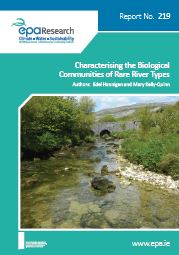Research 219: Characterising the Biological Communities of Rare River Types
Authors: Edel Hannigan and Mary Kelly-Quinn
Summary: Research Report 219 Characterising the Biological Communities of Rare River Types

Identifying Pressures
Under the WFD, all EU Member States are obliged to develop a river typology upon which type-specific reference conditions can be defined to enable the accurate evaluation of ecological status. Ecological status is determined on the basis of deviation from these type-specific reference conditions. Rare or unusual river types were not adequately represented in the development of the 12-type national river typology for Irish rivers. Rare river types in this context are defined as systems that present the biota with a combination of naturally challenging or distinct environmental conditions. The RareType research project aimed to characterise the macroinvertebrate, macrophyte and phytobenthos communities of four potential rare river types: (i) groundwater-dominated rivers, (ii) highly calcareous rivers with calcium precipitate, (iii) naturally acidic rivers, and (iv) rivers strongly influenced by lakes. The RareType project aimed, to determine whether these rivers fit within the national typology and if current water quality assessment methods can adequately assess their condition, and thereby identify those under pressure from anthropogenic activities.
Informing Policy
The RareType research findings provide a solid foundation for making a series of decisions to improve assessment of the true ecological status of sites in rare river types. It will inform policy relating to development of national monitoring programmes by the EPA as well as that related to protection of aquatic biodiversity.
Developing Solutions
The RareType research findings will ensure that monitoring programmes and status assessment target the widest range of river types in Ireland by providing evidence of where designation of separate biological types/sub-types is required. For some stressors such as acid input, it identifies the need for stressor-specific metrics.
https://www.epa.ie/media/epa-2020/publications/research/Thumb-219[1].jpg